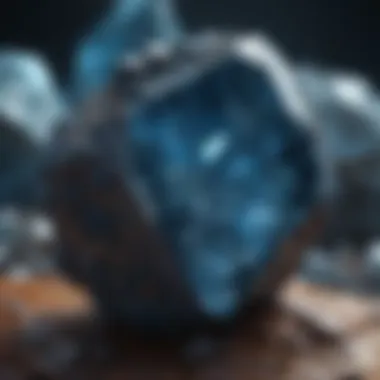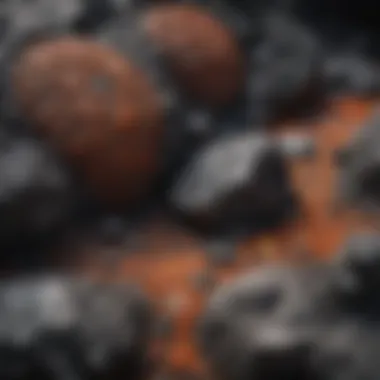A Comprehensive Guide to Identifying Rocks Using Photographs


Overview of Gemstones and Minerals
Gemstones and minerals have held a significant place throughout history, not just for their aesthetic appeal but also for their cultural and societal importance. The history of gemstones and minerals dates back centuries, with civilizations around the world valuing these precious stones for various reasons, ranging from adornment to symbolism. Their significance in culture and society is undeniable, playing roles in rituals, traditions, and even economic activities.
From the formation process to their intrinsic properties, gemstones offer a wealth of knowledge waiting to be explored. Understanding the process through which gemstones are formed provides insight into their unique characteristics. These stones undergo intricate processes within the Earth's layers, resulting in a diverse range of colors, hardness levels, and luster. Gemstones are categorized based on these defining properties, allowing enthusiasts to distinguish between different types with precision and accuracy.
Gemstone Formation and Properties
The formation process of gemstones is a complex journey that unfolds over millions of years. Various geological events and conditions contribute to the creation of these wonders of nature. Factors such as pressure, temperature, and mineral composition play crucial roles in shaping the characteristics of gemstones. Meanwhile, properties like color, hardness, and luster define the allure of each stone, making them unique and coveted.
When it comes to classifying gemstones, the criteria of color, hardness, and luster play pivotal roles. Gemstones can exhibit a rainbow of hues, from vibrant reds to deep blues, each color holding significance and beauty. Their hardness, measured on the Mohs scale, determines their durability and wearability. Additionally, the luster of a gemstone, whether it's vitreous, adamantine, or greasy, contributes to its overall appeal and value.
Types of Gemstones
In the world of gemstones, there exists a distinction between precious and semi-precious stones. While both categories hold value and beauty, precious gemstones like diamonds, rubies, sapphires, and emeralds command a higher price due to their rarity and exceptional qualities. On the other hand, semi-precious gemstones encompass a broader range of stones, including amethyst, citrine, and turquoise, offering diversity and accessibility to enthusiasts.
Beyond the traditional distinctions, there are countless varieties of gemstones awaiting discovery. from the vibrant opals of Australia to the historical jade of China, each gemstone holds a unique story and allure. Moreover, exotic and rare gemstones captivate collectors with their scarcity and exceptional beauty, making them prized possessions in the world of gemology.
Identifying and Evaluating Gemstones
Evaluating a gemstone goes beyond its visual appeal, delving into factors that influence its overall value and quality. Various aspects, such as color intensity, clarity, cut precision, and carat weight, contribute to determining the value of a gemstone. Techniques like spectroscopy, refractometry, and magnification aid gemologists in accurately identifying and classifying gemstones.
When assessing gemstone quality, considerations such as origin, treatments, and inclusions play substantial roles. Origin provides insight into the geological conditions under which a gemstone formed, impacting its rarity and value. Understanding common treatments and enhancements allows collectors to make informed decisions regarding gemstone purchases. Additionally, the presence of inclusions, or internal features, can affect a gemstone's clarity and brilliance.
Caring for Gemstones
Proper care and maintenance are essential to preserving the beauty and durability of gemstones. Cleaning gemstones regularly with mild soap and warm water helps remove dirt and debris, maintaining their luster and shine. Storing gemstones in separate compartments or soft pouches prevents scratches and damage. Avoiding common mistakes such as exposing gemstones to harsh chemicals or extreme temperatures prolongs their lifespan and ensures their longevity.
For specific gem types, certain preservation tips can further enhance their quality and appearance. For example, storing pearls away from other gemstones prevents scratches, while keeping emeralds away from direct sunlight prevents color fading. By following these care practices, enthusiasts can enjoy their gemstone collection for years to come.
Introduction


Overview of Rock Identification
Understanding the Importance of Rock Identification
Embarking on a journey to comprehend the importance of rock identification is akin to decoding nature's tapestry. It serves as the cornerstone in unraveling earth's history, providing insights into past environments, geological events, and mineral formations through the ages. The significance of identifying rocks extends beyond mere curiosity, laying the foundation for disciplines such as mineralogy, petrology, and geological mapping. A pivotal aspect lies in the precision it offers, guiding enthusiasts to label, categorize, and appreciate the diverse rocks scattered across the planet's crust.
Navigating the terrain of rock identification through photography empowers enthusiasts with a tool brimming with potential. The act of capturing rocks in their natural habitat enables individuals to overcome spatial constraints and time limitations when studying specimens. Accessibility undergoes a transformative shift, granting geology enthusiasts the ability to revisit images, examine intricate details, and share findings with a global community. Furthermore, the marriage of technology and geology enriches the identification process, fostering a multidimensional approach to rock analysis.
Common Rock Types
For any enthusiast or collector embarking on a journey of rock identification through photos, understanding common rock types is paramount. Sedimentary, igneous, and metamorphic rocks form the fundamental trinity in geology. Sedimentary rocks, born from sedimentation and lithification processes over time, unveil Earth's history through distinct layers and imprints. Igneous rocks, originating from volcanic eruptions or solidification beneath the surface, boast unique textures and crystalline formations. Metamorphic rocks, shaped by immense heat and pressure, display intricate patterns resulting from intense geological transformations. Recognizing these key categories is the cornerstone of proficient rock identification based on visuals.
Sedimentary Rocks
Characteristics of Sedimentary Rocks
When delving into the characteristics of sedimentary rocks, the focus lies on composition, texture, and fossils present within the rock matrix. Sedimentary rocks showcase a wide array of colors, from soft sandy hues to vibrant reds and yellows, hinting at their geological origin. The distinct layering known as stratification offers insights into depositional environments, evolution, and climate changes. Fossils preserved in sedimentary rocks serve as prime indicators of past life forms and environments, aiding in both geological and paleontological studies.
Examples of Sedimentary Rocks
Illustrating the realm of sedimentary rocks, examples like sandstone, limestone, and shale come to the forefront. Sandstone, recognized by its granular texture and layers of sand grains cemented over time, reflects ancient desert or beach settings. Limestone, composed mainly of calcite, emerges with exquisite patterns and organic remains like shells and corals, narrating marine deposition tales. Shale, with its fissile nature and fine grain structure, highlights quiet deep-water environments where silt slowly settled and compacted. Exploring these examples gives a tangible understanding of the diverse sedimentary rock family.
Igneous Rocks
Distinctive Features of Igneous Rocks
Concentrating on the distinctive features of igneous rocks unveils a world of molten beauty frozen in time. Igneous rocks boast a spectrum of textures ranging from glassy obsidian to coarse-grained granite, hinting at their cooling history. The mineral composition elucidates the magma's original source and the environment in which it solidified. Additionally, crystal sizes within igneous rocks offer crucial insights into the cooling rate and depth of the volcanic or plutonic activity, aiding in precise rock identification.
Identification through Visual Cues
Seeking identification through visual cues in igneous rocks involves decoding mineralogy, color variations, and structural features. The presence of dark-colored minerals like olivine or mafic compositions indicates rapid cooling and volcanic origins, contrasting with light-colored feldspar-rich rocks indicating slower cooling beneath the surface. Recognizing specific textures such as vesicles, formed by gas bubbles, provides clues to the rock's eruptive history. Visual cues play a crucial role in deciphering the origin and classification of igneous rocks through photographic analysis.
Metamorphic Rocks


Key Attributes of Metamorphic Rocks
Exploring the key attributes of metamorphic rocks sheds light on their profound transformation under extreme pressure and temperature conditions. Metamorphic rocks exhibit foliation, a planar alignment of minerals due to directional pressure, lending them a characteristic layered appearance. The mineral recrystallization and textural changes reflect the rock's journey from its protolith to its metamorphosed state, showcasing a complex blend of mineral compositions and structures unique to each metamorphic environment.
Visualization for Identification
Harnessing the power of visualization aids in the identification of metamorphic rocks, as cross-cutting relationships, foliation patterns, and metamorphic index minerals come into play. Observing the distinct color changes, banding, and mineral assemblages through photographs allows for detailed analysis of metamorphic processes and grades. Visualization serves as a crucial tool in unraveling the geological history encapsulated within metamorphic rocks, enhancing the accuracy of rock identification based on photo evidence.
Important Rock Characteristics
Rock characteristics play a vital role in identifying different types of rocks accurately. By understanding the nuances of color and texture, one can gain valuable insights into a rock's composition and origin. The importance of paying attention to these key features cannot be overstated, as they serve as foundational elements in rock identification. In this section, we will delve into the significance of rock characteristics and how they are instrumental in distinguishing between various rock types.
Color and Texture
When it comes to rock identification, color and texture are two critical aspects that enthusiasts and geologists examine closely. The color of a rock provides essential clues about its mineral content and formation process. For example, a reddish hue in sedimentary rocks may indicate the presence of iron oxide, while a dark color in igneous rocks might suggest high levels of magnesium and iron. Texture, on the other hand, refers to the physical appearance of the rock's surface and structure. It can range from smooth and glassy in igneous rocks to coarse and layered in sedimentary rocks. Understanding the role of color and texture is fundamental in classifying rocks accurately.
Role of Color in Rock Identification (Color of Color in Rock Identification)
Color plays a significant role in rock identification by offering valuable insights into a rock's mineral composition. By analyzing the various hues present in a rock, geologists can determine the types of minerals it contains. For instance, a greenish tint in a rock may indicate the presence of olivine or chlorite, while a white color might suggest the dominance of quartz or feldspar. The ability to differentiate rocks based on color is a useful skill that aids in understanding their geological significance and formation history.
Texture as a Clue to Rock Type (Texturse as a Club to Rock Type)
Texture serves as a crucial indicator of a rock's origin and formation process. The texture of a rock can reveal valuable information about its cooling history, pressure conditions, and mineral alignment. For instance, a fine-grained texture in a rock may suggest rapid cooling, common in volcanic igneous rocks, while a banded texture in metamorphic rocks indicates gradual recrystallization under intense heat and pressure. By examining the texture of rocks, geologists can make informed interpretations about their geological context and environmental conditions.
Key Features to Look For
When identifying rocks through photographs, paying close attention to key features becomes paramount. These features serve as crucial indicators that aid in categorizing and understanding the different types of rocks effectively. One noteworthy element to consider is grain size and shape, which offers valuable insights into the rock's formation process and geological history. By examining the grain characteristics, such as the size and arrangement of mineral grains, enthusiasts can decipher valuable information about the rock's origin and the conditions it underwent over time. This level of detail provides a deeper understanding of the rock's composition and allows for a more accurate classification.
Moreover, understanding the significance of interpreting grain characteristics goes beyond mere observation; it requires a trained eye to grasp the subtle differences that distinguish one type of rock from another. By mastering the skill of interpreting these features, individuals can develop a keen eye for detail and precision in rock identification. The ability to analyze grain characteristics with proficiency enhances one's capability to identify and differentiate between various rock types accurately. This skill set elevates the quality of analysis conducted purely through photographic evidence and contributes to a more nuanced understanding of the geological processes that shaped the rocks.
On the other hand, delving into the realm of shape patterns in different rock families unveils a whole new dimension of rock identification. The distinctive patterns found within different rock families serve as distinct signatures that aid in classification and differentiation. By recognizing these unique patterns and understanding their implications, enthusiasts can accurately associate rocks with specific families and geological formations. Understanding shape patterns contributes significantly to the accuracy of rock identification, as it provides additional diagnostic clues beyond grain characteristics alone.
This nuanced approach not only enhances the accuracy of rock identification but also deepens one's appreciation for the intricate patterns and formations present in rocks. By exploring the subtle variations in shape patterns across different rock families, enthusiasts can unravel the unique stories that each rock tells, offering a fascinating glimpse into the geological history recorded within these natural specimens.


Photographing Rocks for Identification
Photographing Rocks for Identification is a pivotal aspect of this article, as it serves as the primary method for identifying and studying rocks visually. By capturing high-quality images of rocks, enthusiasts can delve into the intricate details and characteristics of various rock types. This section offers insights into the essential elements required to take effective rock photos, emphasizing the significance of clear, well-lit images for accurate identification and analysis. Understanding how to photograph rocks with precision is crucial for gemstone enthusiasts, collectors, and geology enthusiasts seeking to broaden their knowledge and appreciation of rocks and minerals.
Best Practices for Capturing Rock Details
Lighting and Angles for Clarity
Delving into the realm of Lighting and Angles for Clarity during rock photography, one uncovers the crux of illuminating rocks effectively. The interplay of light and angles significantly influences the visibility of intricate rock features, aiding in the identification process. Highlighting the importance of optimal lighting conditions and strategic angles, this section guides readers on harnessing light to highlight textural nuances and distinctive markings on rocks. The strategic utilization of lighting and angles enhances clarity, enabling enthusiasts to capture detailed images that facilitate accurate rock identification. Understanding the importance and nuances of lighting and angles establishes a solid foundation for rock photography, ensuring that each detail is illuminated and captured with precision.
Zooming in on Textural Features
Zooming in on Textural Features sharpens the focus on intricate details within rock formations, allowing enthusiasts to explore textures with precision. By magnifying textural elements, such as grain patterns and mineral deposits, enthusiasts can gain a deeper understanding of rock composition and origin. This section highlights the benefits of zooming in to observe textural intricacies closely, enabling enthusiasts to discern subtle differences and unique features within rocks. While zooming enhances the visibility of textural details, it may also unveil unexpected characteristics that aid in rock classification. Understanding when and how to zoom in on textural features empowers enthusiasts to capture comprehensive images that reveal the intrinsic beauty and complexity of rocks, fostering a profound appreciation for the geological uniqueness present in each specimen.
Utilizing Online Resources
Living in the digital era, the utilization of online resources holds paramount importance in the realm of rock identification through photographs. The shift towards digital platforms offers a wealth of benefits, revolutionizing the accessibility and efficiency of rock identification. Through online resources, enthusiasts can partake in a virtual journey into the intricate world of rocks and minerals, transcending geographical barriers and sharing insights globally. One of the key elements to focus on when utilizing online resources for rock identification is the reliability and credibility of the platforms. Ensuring that the websites and apps chosen for reference are reputable and scientifically accurate is crucial in honing one's identification skills. Additionally, considerations about user-friendly interfaces, comprehensive databases, and interactive features enhance the overall experience of utilizing online resources for rock identification. Embracing these digital tools not only sharpens identification skills but also fosters a sense of camaraderie within the community of rock enthusiasts.
Websites and Apps for Rock Identification
Top Platforms for Rock Enthusiasts
The distinguished feature of top platforms for rock enthusiasts lies in their comprehensive database and user-friendly interface. These platforms offer a treasure trove of information on various rock types, characteristics, and identification tips, making them an indispensable tool for rock enthusiasts looking to expand their knowledge. The key characteristic that sets top platforms apart is their commitment to accuracy and scientific rigor in presenting information, ensuring that users receive credible insights into the world of rocks and minerals. A beneficial choice for this article, top platforms stand out for their interactive elements that engage users in a dynamic learning experience, fostering a deeper understanding and appreciation for different rock types. One unique feature of top platforms is the integration of user-generated content and forums, allowing enthusiasts to collaborate, share discoveries, and seek guidance from peers in their rock identification journey. This communal aspect not only enriches the learning process but also creates a sense of belonging within the online rock enthusiast community.
Features to Aid in Identification
When delving into features designed to aid in rock identification, one must acknowledge their pivotal contribution to streamlining the identification process. These features are characterized by their functionality and precision in guiding enthusiasts towards accurate rock recognition. The key characteristic of features to aid in identification is their user-friendly design, which simplifies complex identification techniques and enables users to navigate with ease. A popular choice for this article, these features act as virtual mentors, offering step-by-step guidance and visual cues to enhance the identification experience. A unique feature of such tools is their integration of advanced algorithms and image recognition technology, further augmenting the accuracy and reliability of rock identification. While these features present numerous advantages in expediting the identification process, one must remain mindful of potential limitations, such as dependence on external databases and occasional technical errors that may impact the identification outcomes. Overall, the incorporation of these features into rock identification practices elevates the efficiency and precision of the identification process, empowering enthusiasts to unravel the mysteries concealed within each rock photograph.
Conclusion
Enhancing Your Rock Identification Skills
Practice and Observation as Key Tools
Embarking on the journey of rock identification necessitates a dedicated commitment to practicing and keen observation. Engaging in hands-on activities, such as fieldwork and specimen analysis, allows individuals to refine their capacity to discern subtle differences between rock types. The integration of practice and observation as fundamental tools in the toolkit of rock enthusiasts enables the development of a discerning eye for detail. This meticulous approach not only boosts accuracy in identification but also cultivates a deeper connection with the geological landscapes under study. The rigorous practice paves the way for a comprehensive understanding of rock formations and geological processes, empowering enthusiasts to unravel the mysteries encapsulated within each stone.
Continual Learning in the Field of Geology
Embracing the ethos of continual learning in the sphere of geology is a hallmark of a consummate rock aficionado. By maintaining a steadfast curiosity and a hunger for new knowledge, individuals can stay abreast of the latest discoveries, trends, and advancements in the field of geology. Continuous education serves as a cornerstone for personal and professional growth, fostering an environment ripe for intellectual stimulation and innovation. The proactive pursuit of geological knowledge not only expands one's expertise but also fuels a passion for exploration and discovery. Through continual learning, enthusiasts can embark on a voyage of geological enlightenment, delving deeper into the complex tapestry of rocks, minerals, and earth's dynamic processes.







